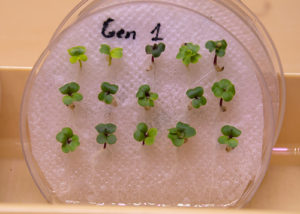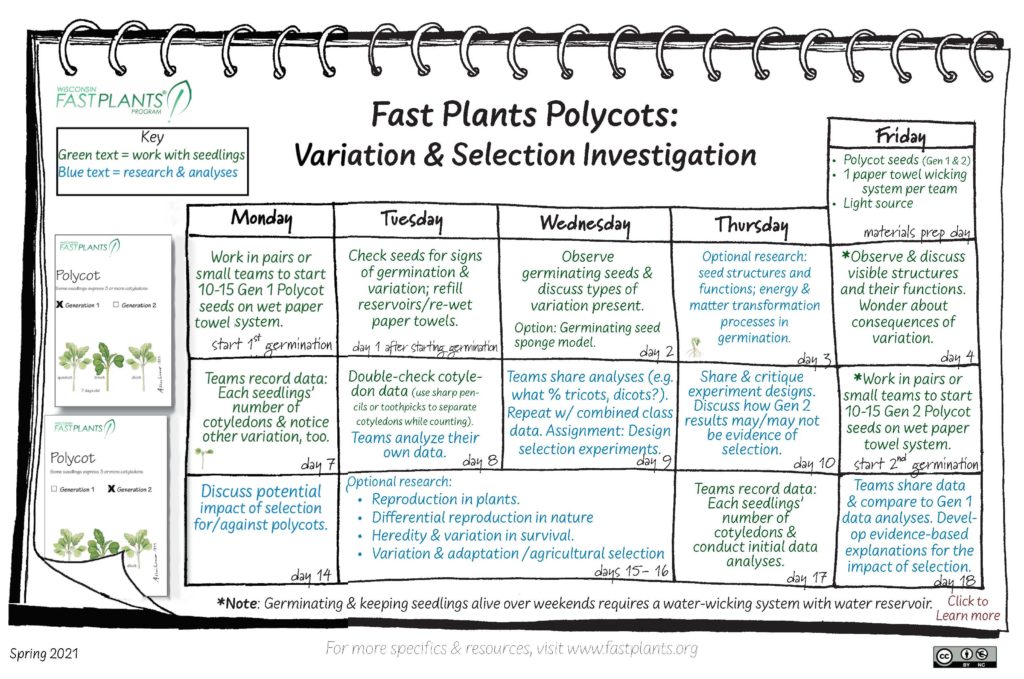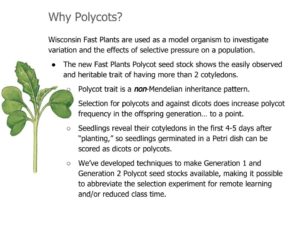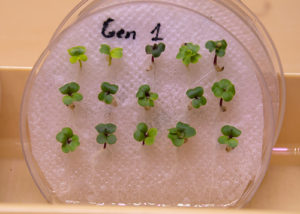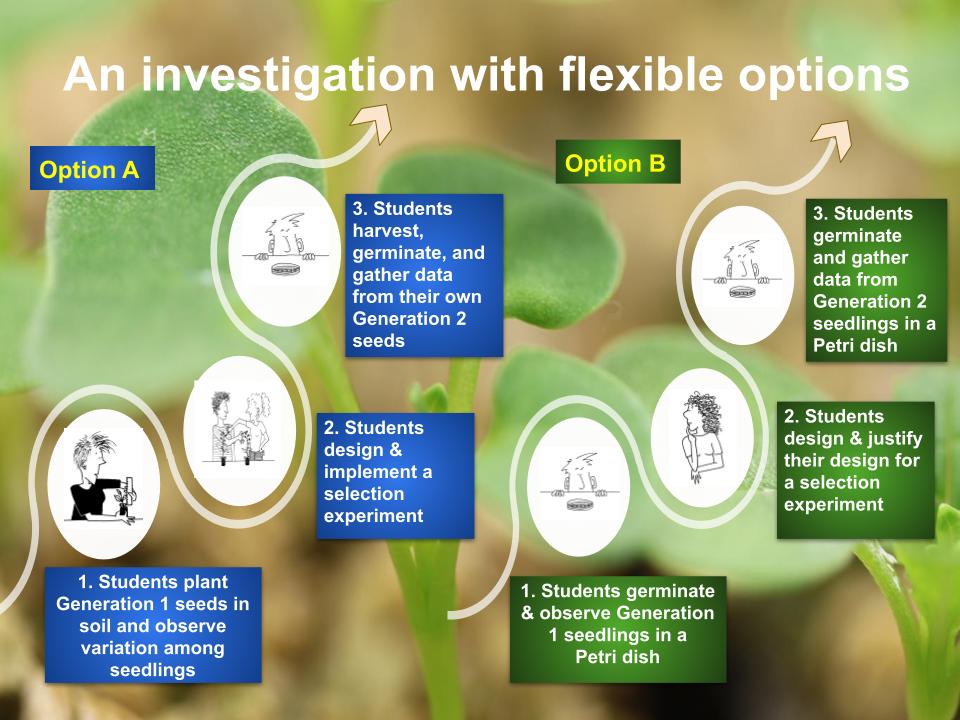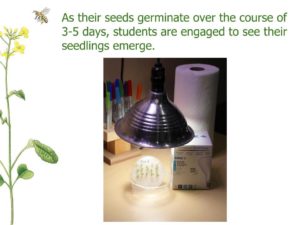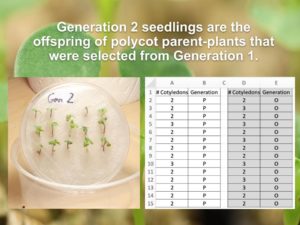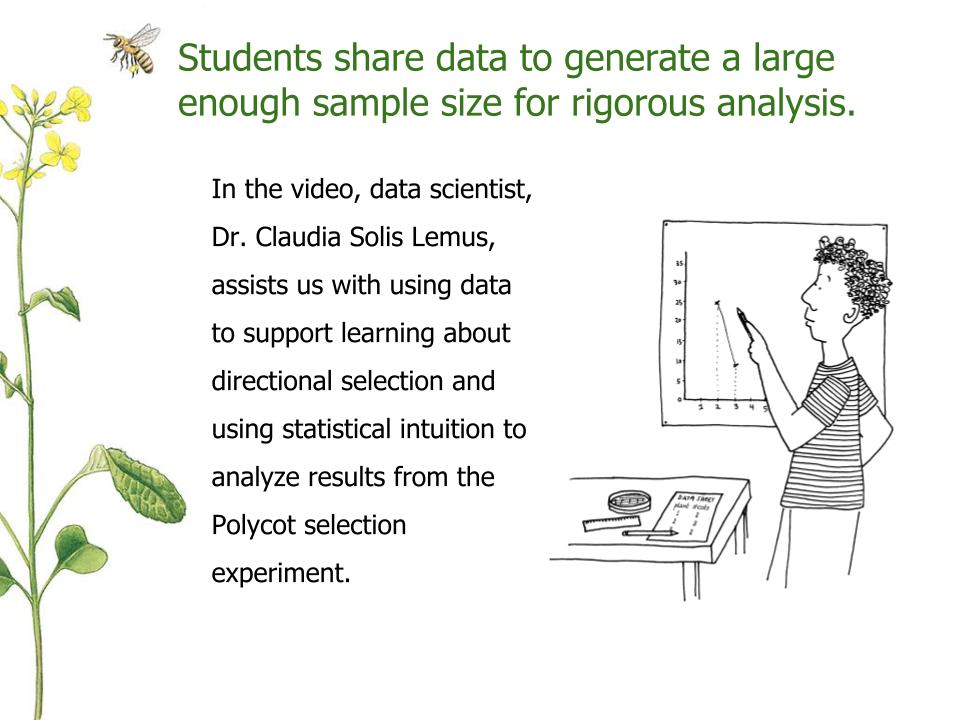Polycot seedlings are easy to distinguish just a few days after germination!
Our new Polycots seed line of Fast Plants features a trait that students can easily see at the seedling stage. In addition, we’ve developed a procedure for producing parental (Generation 1) and offspring (Generation 2) Polycot seed stocks, so it is not necessary for students to produce their own Generation 2 seeds (though, they still can, if time allows). Because of this, it’s now possible to facilitate students’ learning about variation and natural selection through firsthand observations and hands-on data collection in just very short time.
Polycots trait is an easy-to-manage option
Whether teaching general biology, AP biology, agronomy, or ecology courses, Fast Plants are a go-to model organism for teaching fundamental natural selection concepts. Now, we enthusiastically introduce Polycots, a new line of Fast Plants that we specifically developed through traditional breeding techniques for use in teaching the design, implementation, and data analysis of a selection experiment.
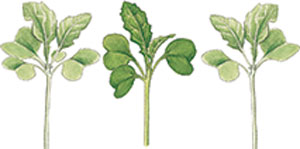
We recognize that some teachers use Fast Plants in student-centered, open-ended selection investigations, allowing students to choose their own observable trait to select for. On the other hand, some teachers prefer to have a pre-determined trait for students to try increase or decrease in frequency in an offspring generation. Either way, before the introduction of Polycots, any Fast Plants selection experiment involved growing and intermating select individuals from a first generation to produce viable seed for growing a second generation long enough to collect data. Typically, the entire investigation took a minimum of 45-55 days (depending on the trait chosen and growing conditions).
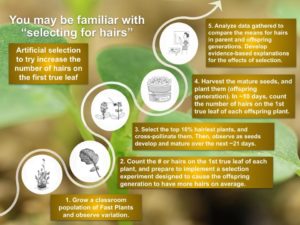
In contrast, Polycots are available in packets labeled as either Generation 1 or Generation 2. This option was made possible because of the Polycot line was bred expressly as a model organism for selection experiments. In addition, our clever Fast Plants breeder, Dan Lauffer, developed along with this new seed line a strategic method for producing at scale Generation 1 and Generation 2 seed stocks. As a result, it is now possible to abbreviate selection experiments to a two- or three-week timeframe.
This post features the abbreviated Polycot selection experiment, as do our new Open Source Polycot lessons that are available for your use. Keep in mind, however, that Generation 1 Polycot seeds are available as a stand-alone, also. Therefore, this new seed line can also be used as a replacement for the full trichome (hair) selection experiment as described in the AP Biology course and other curricula. Click here to view a video introduction to this selection investigation, featuring polycots: Wisconsin Fast Plants selection for the polycot trait: Investigation Overview
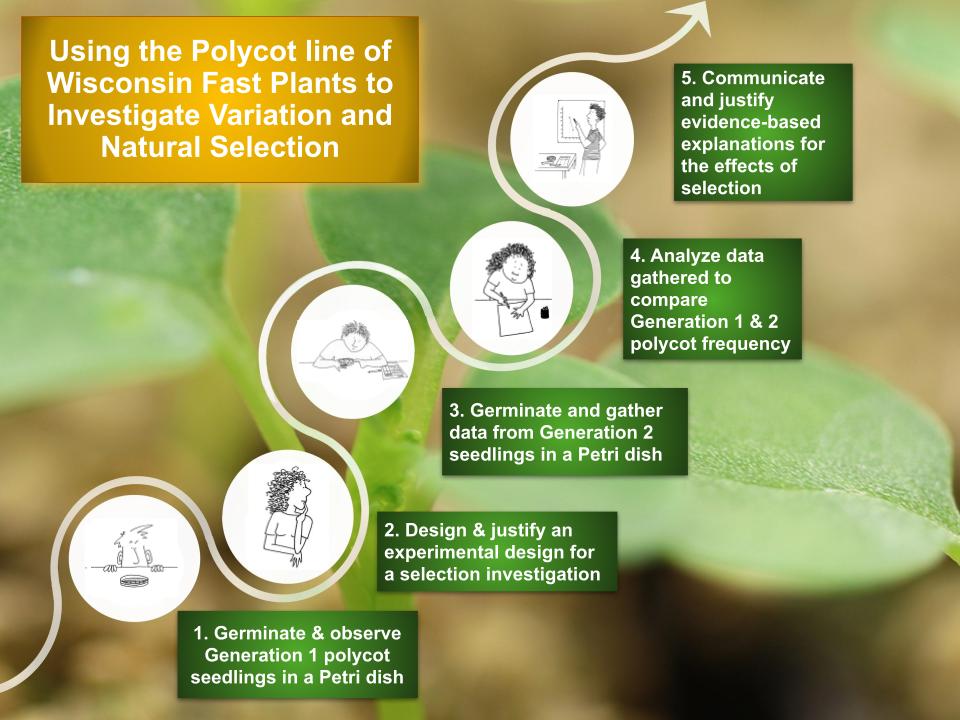
Why choose Polycots for teaching natural selection?
Understanding natural selection begins with the natural phenomenon that individuals in a population show variation in the expression of their traits. For example, in a plant population we can notice and wonder about variation in leaf color, plant height, rates of development, numbers of leaves, etc.. In order for students to witness this variation phenomenon and conduct selection experiments, we need to work with large enough populations of a model organism that variation can be detected and measured with statistical significance. For this reason, using Fast Plants as a model population works well because growing 100+ individual Fast Plants can be accomplished in as little space as a bank of shop lights or much less if only germinating seeds in Petri dishes.
In addition to planning for a sufficiently sized model population, we need to know that any model population we choose will express easy-to-notice (and measure) variation in at least one trait that we can leverage for a selection experiment. Polycots first caught our attention as a great candidate trait for teaching selection because of the ease with which most anyone notices variation in the number of cotyledons on young seedlings. Further, since cotyledons emerge so early, it is possible to begin noticing variation in just 4 or 5 days after planting in soil or germinating Fast Plants seeds on wet paper towel.
Number of cotyledons works well as a trait for selection experiments
Any selection investigation’s success depends on experimental design and implementation that:
- Controls as many environmental variables as possible across both the first and second (offspring) generations, and
- Involves selection for a trait that, to the best of our knowledge, is regulated by genetics, independent of environmental factors.
For this reason, selecting to increase the number of hairs (trichomes) on the margin of the first true leaf on Fast Plants has been a popular trait. Apparently, environmental conditions do not influence the number of hairs expressed; rather, this trait appears to be controlled by the individual’s genetics. This contrasts with the many traits that students are typically drawn to notice independently, like plant height and rate of growth (both of which are heavily influenced by environmental conditions such as temperature that can differ significantly between Generations 1 and 2). Polycots, on the other hand, offer a trait that students easily notice and tend to be curious about (much like four-leaf clovers catch attention). In addition, the polycot trait appears to be determined strictly by genetics (as far as we understand it after 10 years work).
Given how early in the life cycle cotyledons are visible, distinguishing and counting dicots and polycots can be done in the first week. With our new Polycots, it is now possible to choose between teaching the full selection and breeding investigation in which students select individuals from Generation 1 to intermate and produce Generation 2 (shown as Option A, below) or an abbreviated version of the investigation (Option B) that is featured in this post. Whichever option you choose to use or adapt, students have the opportunity to gather and interpret firsthand data with polycots. As a result, students engage in Next Generation Science Standards aligned experiences with analyzing and interpreting variation data.
Expedited investigation with polycots
Reducing class time needed for hands-on investigations used to teach natural selection concepts can make a big difference when it comes to deciding how to teach this fundamental biological principle. That is why we spent over a decade developing the Polycots line of Fast Plants to use in selection investigations. Now, we are able to design selection investigations that use seedlings germinated on paper toweling for two generations of polycots without having students necessarily produce the second generation.
Designing a selection investigation with Polycots
Experimental design is an important step in conceptualizing how “artificial” and “natural” selection occur. Therefore, we include the experimental design process as a thought experiment in this investigation with Polycots. In this way, students engage with conceptualizing what must happen to select and intermate only the plants in Generation 1 that have three or more cotyledons to try increase the frequency of polycots in Generation 2. A sample experimental design is included in the Polycots Investigation Lesson Plans (available for teachers to adapt and use; please complete the form at the end of this post for free access).
Observing and recording Generation 1 & 2 Polycots data
Polycots that are four or five days old can be distinguished from dicot seedlings by separating the cotyledons with a sharp pencil or other probe. In some cases, extra cotyledons may overlap, so it is helpful to carefully tease apart the cotyledons when gathering data (counting and recording the number of cotyledons for each seedling).
Fortunately, with cotyledon count as a focus trait, magnification is not needed for data collection, and observations can be made anytime between four and seven days after starting the seeds to germinate. In fact, seedlings germinated on paper towel can be placed in a refrigerator to stop their growth if you find it helpful or necessary to delay when students observe and gather cotyledon data.
Analyzing experimental data from Generations 1 & 2 Polycots
From observing Generation 1 and Generation 2 Polycots that were germinated on paper towel, students can find evidence to support or refute the claim that selecting for polycots increased the percentage of polycots in the offspring generation. Analyzing these data is a critical step in the investigation. Students have the opportunity to learn how to compare data from the Parent generation (1) to data collected from the Offspring generation (2) to determine if there is a cause (selection) and effect (trait frequency) relationship.
Often, a t-test is used to compare two sets of data. However, in selection experiments, we typically rely on a Chi-squared analysis. For a clear explanation about what each of these statistical analysis techniques can and cannot do for us in the context of this investigation with Polycots, watch this explanatory video with data scientist, Dr. Claudia Solis-Lemus: Analyzing Polycots data from Generation 1 & 2
Dr. Solis-Lemus also introduced in this video a new statistical tool that she and her student, Yizhou Liu, developed for conceptualizing and analyzing Fast Plants and other data. The Wisconsin Fast Stats App is an Open Source app available here: https://wi-fast-stats.wid.wisc.edu/cotyledon/
Contribute to building Open Source Lessons with Polycots
We would love to hear from you about your experiences teaching with the new Polycots line of Fast Plants. Please, let us know how you adapt or design new lessons for teaching with Polycots, so we can all continue to learn together. Either drop us a note in the comments below, or send us an email, and we’ll continue to keep the Fast Plants community updated with new developments.
As always, we are immensely grateful to all of you who make a commitment to teach with plants. We know, the best way to really know a plant, is to grow a plant!
To access all the teaching materials for the Polycot selection investigation, please complete the form below:


